Awards Ceremony, President's Day 2013 (Wednesday 5 June)
Mr David Shilston, President opens proceedings.
Ladies and Gentlemen,
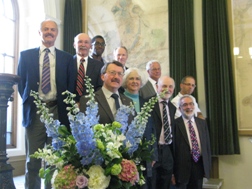 As an engineering geologist, and especially as the first to be President of this Society, it gives me particular pleasure to begin the Awards Ceremony today with a word or two about the applied and industrial geology awards made by this Society through the year.
As an engineering geologist, and especially as the first to be President of this Society, it gives me particular pleasure to begin the Awards Ceremony today with a word or two about the applied and industrial geology awards made by this Society through the year.
Picture: Mr David Shilston (front row, foreground) and the 2013 Medal Winners
Some awards for applied work you will see presented later today. However, there are others, including three highly prestigious industry awards made by three of this Society’s specialist groups.
The Hydrogeological Group awards the Whitaker Medal, which last went to independent consultant Tony Marsland. The Petroleum Group’s highest honour is its Silver Medal, which last went to oil explorationist Peter Rose; while the Engineering Group awards the Glossop Medal, won most recently by engineering geologist and quarry designer, Ruth Allington. These medals are in no way inferior to those awarded by Council’s Awards Committee, and I think their winners fully deserve to receive the first round of applause for today.
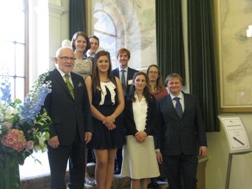
While on the subject of applied geoscience, it is timely to mention the Neil Duncan Award. This award encourages the next generation of applied geologists, following in the footsteps of William Smith, whose reputation we now revere but who was not a Fellow. However he was the first Wollaston Medallist – of which more anon.
Picture: 2013 Prize and Fund winners.
The Neil Duncan Award is a Bursary given by this Society to a student at Portsmouth University. Neil Duncan is a Senior Fellow who was responsible for starting the renowned Engineering Geology & Geotechnics Course at Portsmouth in 1967.
 The Portsmouth Department makes this award in honour of that achievement, which this year goes to Charlotte Victoria Brill-Edwards (pictured, left).
The Portsmouth Department makes this award in honour of that achievement, which this year goes to Charlotte Victoria Brill-Edwards (pictured, left).
Anyone who has ever been President of anything will know that your colleagues keep you on a tight rein most of time. But we begin today with two Awards that are in my gift. Please be reassured that I seek advice from people who can recognise rare promise when they see it; but the final choices are all mine. Which is why these are called the ‘President’s Awards’.
Nicholas Brantut (President’s Award)
The first President’s Award goes to Nicolas Brantut, an exceptionally gifted young scientist based in University College London who examines the overlaps and interactions between physical processes of seismic slip and the chemical and mineralogical changes induced by its effects, such as frictional heating. His work is complex and cutting-edge and combines mathematical modelling and experimental techniques. In 2011 he showed that latent heat of reaction and vaporisation buffer the temperatures along fault lines during earthquakes, which suggests that when faults pass through hydrous minerals, heating causes dehydration and latent heat absorbed reduces temperature rise. He postulated that this buffering explains why fault zones often show lower than expected heat flow and why frictional melts are less common than simpler models would predict.
Nicholas, who sadly cannot be with us today, displays an unusually broad range of skills at an early stage in his career, and it is my pleasure to give him the first President’s Award today.
Matthew Pound (President’s Award)
 The second President’s Award today goes to Dr Matthew Pound of Northumbria University. His research aims for a holistic understanding of climate change during the Paleogene and Neogene. Focusing on the Miocene, Matthew has produced global vegetation maps based on a comprehensive synthesis of palaeobotanical data. This work has revealed just how little we knew about the UK during that period. The Brassington Formation of Central England, whose age was previously poorly constrained, is now known to be of Late Miocene, probably Tortonian age. This in turn has profound implications for dating the uplift of the Pennines during the Alpine Orogeny.
The second President’s Award today goes to Dr Matthew Pound of Northumbria University. His research aims for a holistic understanding of climate change during the Paleogene and Neogene. Focusing on the Miocene, Matthew has produced global vegetation maps based on a comprehensive synthesis of palaeobotanical data. This work has revealed just how little we knew about the UK during that period. The Brassington Formation of Central England, whose age was previously poorly constrained, is now known to be of Late Miocene, probably Tortonian age. This in turn has profound implications for dating the uplift of the Pennines during the Alpine Orogeny.
Matthew Pound, you are a careful and meticulous scientist of great promise, with an impressive list of highly cited publications in prestigious journals that have already garnered you an excellent international reputation. It is my pleasure to confer this Award upon you today.
Before we move onto the Society’s main awards for 2013, we have great pleasure in welcoming back the winner of the special 2012 Fermor Prize.
 Early in 1991 the Society received a significant bequest from Lady Frances Mary Fermor to establish the Fermor Fund as a memorial to her husband, Sir Lewis Leigh Fermor FRS. On the twentieth anniversary of that bequest, the Society invited bids for small grants to support research or conference attendance, as well as bids for a prize to be awarded to independent undergraduate projects.
Early in 1991 the Society received a significant bequest from Lady Frances Mary Fermor to establish the Fermor Fund as a memorial to her husband, Sir Lewis Leigh Fermor FRS. On the twentieth anniversary of that bequest, the Society invited bids for small grants to support research or conference attendance, as well as bids for a prize to be awarded to independent undergraduate projects.
The winner of the special 2012 Fermor Prize was Ross Anderson, who is now completing a PhD under Professor Andy Knoll, the Society’s 2007 Wollaston Medallist, at Harvard University. Ross also won a research grant that enabled him to attend the 2012 Fermor Meeting; and we are delighted to welcome him back to receive his recognition formally, today. Ladies and gentlemen, Ross Anderson.
Richard Moody (Distinguished Service Award)
We come now to the Society’s Distinguished Service Award.
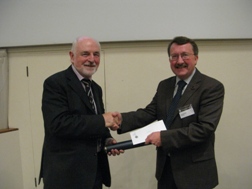 This year’s recipient, Dr Dick Moody, probably requires little introduction to Fellows of this Society, or members of the Geologists’ Association, for he has been an active member of both for over half a century.
This year’s recipient, Dr Dick Moody, probably requires little introduction to Fellows of this Society, or members of the Geologists’ Association, for he has been an active member of both for over half a century.
Dick graduated in 1961 from Queen Mary College in London and trained as a teacher in Swansea in 1962. He taught at secondary level for a couple of years before joining Kingston College of Technology as curator & junior lecturer in palaeontology, stratigraphy and sedimentology. He completed his PhD on Eocene sea-turtles in 1970 and developed first degree and masters courses at Kingston as it became a polytechnic, and then a university. Dick became Director of Kingston Geological Services – a university research and consultancy group - in 1985, and became Professor in 1988. As a proponent of ‘Kingston Alumni’ (which has over 1100 correspondents and rising) Dick is a great motivator.
Dick has served on the former Council for National Academic Awards, the Earth Science Education Group, the councils of this Society and the Geologists’ Association, and numerous other international and Royal Society subcommittees. He has had a hand in writing 26 books, including three of the Society’s Special Publications, as well as over 150 industrial reports, together with courses for the Petroleum Exploration Society of Great Britain and oil companies, led eight trans-Saharan expeditions and 42 oil company field trips in Tunisia and Libya. He has written or co-authored over 80 papers on fossil sea-turtles, the trans-Saharan Seaway, Cenozoic carbonates of North Africa, chemostratigraphy and history of geology.
As Geologists’ Association President from 1998 to 2000, Dick organised two ‘Earth Alert’ conferences in Brighton and Scarborough. He has also organised seven symposia as well as (in 2007) the joint bicentennial dinner of the Dining Club and the Society, in period costume, at the Connaught Rooms, which now bears a plaque commemoration the Society’s foundation.
Dick Moody, for your indefatigable work and contributions to so many aspects of geological life both in the UK and internationally, we are delighted to award you the Distinguished Service Award of The Geological Society of London.
Alison Rust (Murchison Fund)
 The Murchison Fund of the Society is awarded to Dr Alison Rust of Bristol University, where she was appointed Lecturer and Royal Society University Research Fellow in 2006, following her PhD at the University of Oregon and post doc work at the University of British Columbia. A highly interdisciplinary scientist, she began her research career studying how bubbly magmas flow. She combined experimental measurements of permeability with observations on the textures of volcanic products to understand better how magmas lose gas during eruptions.
The Murchison Fund of the Society is awarded to Dr Alison Rust of Bristol University, where she was appointed Lecturer and Royal Society University Research Fellow in 2006, following her PhD at the University of Oregon and post doc work at the University of British Columbia. A highly interdisciplinary scientist, she began her research career studying how bubbly magmas flow. She combined experimental measurements of permeability with observations on the textures of volcanic products to understand better how magmas lose gas during eruptions.
Alison has worked with mathematicians and engineers to introduce techniques applicable to solving geophysical problems in new ways. This is now leading her to develop a new understanding of the acoustic signals emitted during explosive volcanic eruptions, which have been shown to be useful as a volcano monitoring tool that can record distant, unobserved eruptions.
Alison is also a keen and talented communicator of her work, not only with a range of creative educational publications and masterclasses in the mathematics of volcanology for 12-13 year olds, but also through such innovative media as fudge and cake making. Alison Rust, we are pleased to award you the Murchison Fund of The Geological Society of London.
Siwan Davies (Lyell Fund)
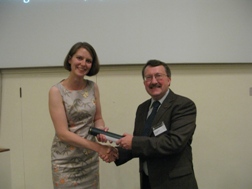 The Lyell Fund of the Society is awarded this year to Siwan Davies of Swansea University. Siwan’s rise has been stellar. Following a first degree at Oxford University and an MSc at Royal Holloway, University of London, she completed her PhD at Royal Holloway in 2003. After spells as a postdoc in Stockholm and Copenhagen, Siwan was appointed lecturer in Swansea in 2004 and received a personal Chair in 2012. In the previous year she won two highly prestigious awards: a European Research Council Starting Grant and a Philip Leverhulme Prize. She has also won two NERC grants, and yet another Leverhulme Trust grant.
The Lyell Fund of the Society is awarded this year to Siwan Davies of Swansea University. Siwan’s rise has been stellar. Following a first degree at Oxford University and an MSc at Royal Holloway, University of London, she completed her PhD at Royal Holloway in 2003. After spells as a postdoc in Stockholm and Copenhagen, Siwan was appointed lecturer in Swansea in 2004 and received a personal Chair in 2012. In the previous year she won two highly prestigious awards: a European Research Council Starting Grant and a Philip Leverhulme Prize. She has also won two NERC grants, and yet another Leverhulme Trust grant.
Siwan’s research uses volcanic ash layers to synchronise the different records of climate and environmental change, mainly in the North Atlantic where tephra layers deriving from Iceland – each with its own distinctive geochemistry – are found in many sediment archives. Her work enables the records from different archives to be tied together with great precision, with major implications for understanding both the mechanisms and rate of climate change.
Siwan Davies, for your invaluable work in precisely correlating and thus enhancing the value of palaeoclimate databanks, please accept the Lyell Fund of The Geological Society of London.
Marie Edmonds (William Smith Fund)
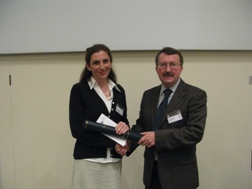 The William Smith Fund goes this year to Dr Marie Edmonds of Cambridge University.
The William Smith Fund goes this year to Dr Marie Edmonds of Cambridge University.
Marie Edmonds is a geochemist and igneous petrologist currently working as Lecturer at the University of Cambridge. She researches the volatiles in magmas and how they can affect the dynamics of eruptions, volcanic hazard and climate. She has helped to pioneer novel applications in the monitoring of volcanic gases, setting up the first automated scanning spectroscopic system for the continuous measurement of sulphur dioxide emissions on Montserrat in 2002. Here she was able to show how hydrochloric acid gas emissions are coupled to magma ascent, whereas sulphur dioxide was emitted when no magma was erupting, showing different sources for these components.
Marie is still the driving force behind continuing gas measurement on Montserrat, at whose observatory she worked as volcanologist before being awarded a prestigious Mendenhall Postdoctoral Fellowship with the United States Geological Survey at Hawaii Volcano Observatory. Here she extended her work to understanding the degassing of basaltic systems.
Marie Edmonds, for your pioneering research, and strong involvement with science communication (including one appearance here as Shell Lecturer), please accept the William Smith Fund of The Geological Society of London.
James Wookey (Wollaston Fund)
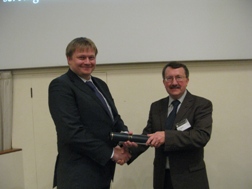 The Wollaston Fund of the Society goes this year to James Wookey of the University of Bristol – an exceptional young seismologist who is changing the way we view the deep Earth.
The Wollaston Fund of the Society goes this year to James Wookey of the University of Bristol – an exceptional young seismologist who is changing the way we view the deep Earth.
Graduating at Warwick University in physics, James moved to Leeds for his PhD to work with Mike Kendall, using an extensive teleseismic set to map out regions of anisotropy in the middle mantle. This extremely demanding project called for considerable computing expertise, and during the course of his research James has developed numerous computer programs and toolkits, many now freely available to the community.
James has since turned to the Core-Mantle Boundary, increasingly seen as an important region for understanding the dynamics of mantle flow. Collaborating with mineral physicists, he has demonstrated that mineral behaviour under deep Earth conditions is consistent with the observations of seismology. Most remarkably, he has been able to draw out subtle features of seismograms that identify hitherto elusive shear waves propagating through the solid inner core, and enabling him to speculate about the possible fabrics that may be present there.
James Wookey, you are a highly talented scientist of great potential – in recognition of which we are delighted to award you the Society’s Wollaston Fund.
Hans Hagdorn (R H Worth Prize)
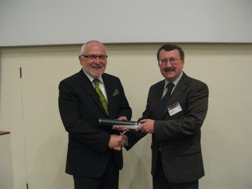 The R H Worth Prize celebrates the practice and encouragement of geological science by and among amateurs. This year we are pleased to award it to one of Germany’s foremost Triassic palaeontologist-stratigraphers and science popularisers, Hans Hagdorn.
The R H Worth Prize celebrates the practice and encouragement of geological science by and among amateurs. This year we are pleased to award it to one of Germany’s foremost Triassic palaeontologist-stratigraphers and science popularisers, Hans Hagdorn.
Hans Hagdorn studied to become a language teacher at Tübingen University, and although he subsequently took up a teaching position he continued his private passion, amassing one of the finest collections of Muschelkalk fossil materials in existence. The collection has always been made freely available to academics and amateurs alike, originally in Hans’s home.
In 1998 the Muschelkalk Museum Ingelfingen opened in a historic community building. Ever since, this has held the Hagdorn collection at the heart of its 50,000 plus specimens – a place of pilgrimage for everyone with an interest in the Triassic. Two years later, in 1998, Hagdorn encouraged the Hohenlohe quarry industry to set up the Alberti Foundation with the purpose of establishing a prize for extraordinary merits in palaeontology.
Hans is more than simply a collector and curator – his publications number about 150 and cover all aspects of the faunas and stratigraphy and environments of the Muschelkalk. In 1991 he organised a symposium that brought together scientists from both sides of the Iron Curtain, in an outstanding demonstration of the power of science, and perhaps geology in particular, to unite the peoples of the world. He continues to develop links all over the globe, particularly with Chinese palaeontologists through a joint research grant to study the environments and fauna of China’s marine Triassic.
In 1988 Hans was awarded an honorary doctorate from the University of Tübingen and he has served on the Council of the German Palaeontological Association.
Hans Hagdorn, please accept with our admiration and respect, the R H Worth Prize of The Geological Society of London.
Henry Frankel (Sue Tyler Friedman Medal)
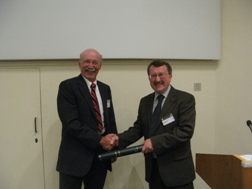 The Sue Tyler Friedman Medal, awarded for excellence in research into the history of geology, was endowed by a Foundation established by one of this Society’s Senior Fellows – the late distinguished carbonate sedimentologist and historian of science, Professor Gerald Friedman. The Award, named for Gerald’s wife, goes this year to Henry Robert Frankel, of the University of Missouri-Kansas City.
The Sue Tyler Friedman Medal, awarded for excellence in research into the history of geology, was endowed by a Foundation established by one of this Society’s Senior Fellows – the late distinguished carbonate sedimentologist and historian of science, Professor Gerald Friedman. The Award, named for Gerald’s wife, goes this year to Henry Robert Frankel, of the University of Missouri-Kansas City.
Hank Frankel has made a long-term and determined effort to understand the central scientific issues involved in the continental drift controversy – not just the ideas that ‘won’, but also the dead-ends and blind alleys that caused all the muddles along the way. From an exhaustive study of original sources, he has now published what must surely be the definitive account of the evolution of ideas that led from continental drift to plate tectonics. His massive four-volume work, The Continental Drift Controversy (2012), now provides anyone writing about this field in the future with a uniquely authoritative account – one that has been read and commented upon by many of the participants themselves. Moreover, this monumental work captures for future generations – including, crucially, students of the history of science – the unique way that knowledge is created in Earth science.
Herein lies the work’s particular importance. Hitherto, accounts of knowledge-making in science have concentrated mostly on physics and chemistry where there is a clear interaction between theory and experimentation. However, the way an area of science develops in the absence of classical experiment, as is the case with much of our subject, is quite different from this general paradigm. For this reason Frankel’s book should influence the teaching of History of Science everywhere.
Henry Robert Frankel, please accept with our deep respect and gratitude, the Sue Tyler Friedman Medal of The Geological Society of London.
Hank Frankel replied:
Mr. President, thank you for your kind words.
I took no geology courses while an undergraduate at Oberlin College during the first half of the 1960s. My loss! Studying philosophy of science at Ohio State in the late 1960s, I became interested, like most philosophers of science at the time, in scientific controversies. In the middle-1970s when I finally learned of continental drift and plate tectonics while teaching a history of science course at the University of Missouri-Kansas City, it took no imagination to see that I should test philosophical accounts of scientific change against them. Where had I been for the preceding decade? After writing papers on different aspects of the controversy, I decided to pull them together as a book. I began talking in earnest to key participants in the controversy and development of plate tectonics. Two participants, Ted Irving and Dan McKenzie gently told me that I had much more to learn. With their encouragement and help, and with help from many participants, I began anew. I also stopped treating the drift story as a way to test philosophical views and began trying to figure out what actually happened.
I am particularly pleased and honored to receive the Sue Tyler Friedman Medal of The Geological Society of London. Many participants in the story I have grown to love have been honored with your medals. Wollaston Medal recipients include David, Seward, Daly, Bailey, Holtedahl, Holmes, Vening Meinesz, Jeffreys, Bullard, Ewing, Bagnold, Romer, Wilson, McKenzie, Matthews, Le Pichon, Morgan, Trümpy, and Irving. Recipients of other medallists include Arkell, Chaloner, Dorothy Hill, Joly, Westoll, and Vine. Moreover, and to my delight, the Geological Society of London has begun an archive on the history of plate tectonics, and already plans to house the papers of Irving, McKenzie, and Vine – an excellent beginning.
Christopher Jackson (Bigsby Medal)
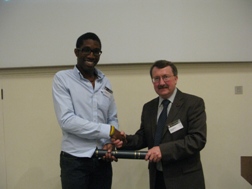 We come now to the Bigsby Medal, which this year goes to Christopher Aiden-Lee Jackson of Imperial College London.
We come now to the Bigsby Medal, which this year goes to Christopher Aiden-Lee Jackson of Imperial College London.
Chris Jackson is arguably the leading and most productive interpreter of three-dimensional seismic reflection data of his generation, using his skill to understand diverse processes in sedimentary basins. However he has also applied his skills to such subjects as magma migration, mass wasting, faulting patterns through time, and the complex interplay between erosion and deposition.
Chris Jackson’s principal research demonstrates excellence in many individual sub-disciplines, which he combines to create a truly holistic understanding of the way in which sedimentary basins develop. This work is of great economic importance, because it helps to reduce the risk in frontier exploration areas, as well as to locate new reserves even in mature hydrocarbon provinces.
His work on rift-basin models has constrained the timescales over which faulting occurs and migrates within the crust, and has shown how folding is more significant in these basins than was previously thought. He has demonstrated that rifts which develop in areas of crust where there are markedly weak layers, such as salt, behave in a markedly different way from those that form in homogeneous crust. And he has integrated structural and stratigraphic data to investigate how the growth of folds, faults and salt bodies influence sedimentation, going on to apply three dimensional seismic reflection to a staggeringly wide range of geological processes.
Chris is a prolific convener of conferences and symposia, has supervised 17 research students, mentored seven postdocs, amassed oil industry research funding amounting to some three and a half million pounds since 2004, and has over 40 peer-reviewed papers either published or in press.
Christopher Jackson, for your wide-ranging application of 3D seismic reflection techniques, please accept the Bigsby Medal of The Geological Society of London.
Chris Jackson replied:
Thanks to the Geological Society for this award; I am shocked, but honoured.
John Jeremiah Bigsby was, like me, from the East Midlands—I was born and raised above the Widmerpool Gulf, which is a Carboniferous-age extensional basin. Thus it was perhaps inevitable that, despite all that is claimed in my citation, rift evolution is still central to my research.
As you have just heard, “diverse” and “wide-ranging” have been used to describe my research; it may be more accurate to use “unfocused” and “distracted”. My esoteric research interests arise because I am interested in, but confused by, many geological processes and their products. This unfortunate affliction started during my PhD, which used fieldwork AND seismic data to better understand the structure AND stratigraphy of rifts; with such a background, how could I ever concentrate on only one area of the geosciences?
As is rightly customary in these circumstances, I must thank a few people who have and continue to influence how and why I do my research; Rob Gawthorpe, for getting me started; Howard Johnson and Dave Hodgson, for keeping me going; and Joe Cartwright, who through his research and our brief conversions, has taught me to ask research questions you probably can’t answer, apply techniques you don’t fully understand and, perhaps most importantly, to enjoy every minute of it. In the words of Richard E. Grant, “…if you want true happiness, make your hobby your job….”
Although the criteria have changed over time, the Bigsby Medal is awarded to someone who “…is probably not too old for further work, and not too young to have done much….”. The threat implicit in the second part of this definition provides me with yet another reason to get out of bed and to go and do the job I love. Again, thanks to the Geological Society for awarding me this great honour; I will now set about trying to justify it.
Peter Burgess (Aberconway)
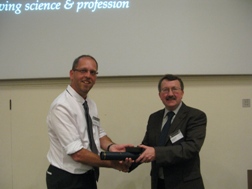 The stated aim of the Aberconway Medal is “to recognise distinction in the practice of geology with special reference to work in industry”, and this year it is awarded to Professor Peter Burgess of Royal Holloway, University of London.
The stated aim of the Aberconway Medal is “to recognise distinction in the practice of geology with special reference to work in industry”, and this year it is awarded to Professor Peter Burgess of Royal Holloway, University of London.
Peter Burgess is an extremely created Earth scientist, a world leader in the application of numerical modelling techniques and methods of quantitative analysis to the understanding of sedimentary systems and their preserved stratigraphy. This research has been translated into practical techniques and applications that have proved invaluable to the hydrocarbon exploration and production, most notably via his work in the oil industry, when he was Senior Geologist with Shell International.
Moving to academe in 2010, his research has continued to challenge and refine the conceptual basis of sequence stratigraphy, combining observation with quantitative testing and numerical modelling tools that demonstrate a keen intellectual curiosity.
Highlights include his characterisation of the nature of order and disorder in sedimentary systems, especially shallow water carbonates. He has investigated the role of controls other than relative sea-level (the dominant control implicit in sequence stratigraphy) on the architecture of stratigraphic sequences - putting numbers on such aspects as the role of sediment supply to deltas in delivering sediment to the shelf-edge and basin floor independently of sea-level change.
Of particular economic importance has been his development of modelling techniques to aid prediction of hydrocarbon reservoir distribution in those dreaded ‘data-poor settings’, with a focus on quantifying uncertainty and risk.
Peter has been effective in fostering links between industry and academe, through student supervision and masters degree teaching. His research is documented in 29 seminal papers and book chapters in peer-reviewed publications, and he has supervised 12 doctoral and MPhil students and convened many well-attended industry-relevant conferences.
Peter Burgess, for your mastery of numerical modelling techniques of huge value to industry and for your extensive fostering of industry-academic links, please accept today the Aberconway Medal of the Geological Society of London.
Peter Burgess replied:
Thank you Mr President, and thank to the Awards Committee, Council and nominators for this award. It is a great honour to receive it, but also rather a surprise. I am very lucky to be able to research and teach in a subject that I love, and to receive a medal for doing what you most enjoy is very much an unexpected bonus.
No one does this kind of work alone, and so I owe thanks and acknowledgement to a lot of people. Clive Boulter, Stuart Egan, Phil Allen, Tony Watts, Mike Gurnis, Steve Flint and Joe Cartwright and Paul Wright have all been key mentors and advisors in my academic career. Phillip and Paul deserve special mention. Philip was my Phd supervisor and once said that I would question everything. He could just have meant that I am an argumentative pedant of course, but I chose instead to interpret it as a vote of confidence, so Phil, thank you. Paul Wright has been a colleague, mentor and friend ever since he told me he didn’t see the point of numerical modelling. He still doesn’t like difficult sums, as he puts it, but I think he is more persuaded now that this kind of modelling is useful.
Many people in Shell including team mates Cees Van Oosterhout, Henne Lammers, Peter Winefield, and Hemmo Boscher, and various team leaders Gary Steffens, Peter Spaak, Paul Wagner, and Richard Knight have been particularly key in helping me begin to understand how hydrocarbon exploration is done, what the challenges are, and how to begin to address them. Thank you to them.
Finally, I would like to say thank you to my wife Caroline and to my parents for their support. My father died a few years ago, but I think he would have liked to see that buying me that computer when I was twelve really did pay off.
Ian Sims (Coke Medal)
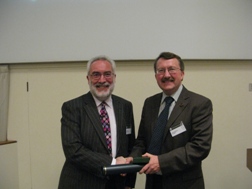 We now come to the Society’s two Coke medals, awarded to geoscientists who have made a significant scientific contribution and been of significant service to geology through activities of benefit to the community.
We now come to the Society’s two Coke medals, awarded to geoscientists who have made a significant scientific contribution and been of significant service to geology through activities of benefit to the community.
The first of these medals to be awarded today goes to Dr Ian Sims, a Director at RSK Stats Ltd., here in the UK.
Ian Sims is an industrial geoscientist specialising in concrete and geo-materials, having – with two co-authors – written the world’s one and only textbook on the subject of investigative techniques for concrete petrography. This unique work, which Ian and Alan Poole have just finished updating, together with over 100 research papers, has helped the United Kingdom to become a world leader in this vital, multi-billion dollar international industry in which Ian is a leading consultant. His pioneering research into concrete petrography, and investigative techniques for the various chemical ‘diseases’ to which concrete and other constructional materials are prone, have not only been of economic importance but have performed a service to public safety all over the world.
Ian’s work for the Geological Society and geoscience in general has included, over a span of over 40 years, dedicated service to the working parties that produced our trilogy of Engineering Geology Special Papers: Aggregates, Stone in Construction and Clay in Construction; as well as our Engineering Group’s Hot Deserts Working Party whose report was published recently by the Society Publishing House (with another deservedly big flourish in Geoscientist.)
His wider service to the community includes membership of national and international technical committees, including three periods (totalling 24 years to date) as Secretary to the technical committees of the International Union of Laboratories and Experts in Construction Materials, Systems & Structures (RILEM, for short, from its French title).
Ian Sims, you are indeed a deserving winner. Please accept, with our thanks and admiration, the Coke Medal of The Geological Society of London.
Ian Sims replied:
Thank you, Mr President, for your kind words. It is a great honour to receive this medal from you and my fellow geologists.
At school, I had hoped to be an archaeologist and was misguidedly advised to become a teacher, the long summer holidays then being available for digging! I soon realised the error and, in searching for an alternative way ahead, I discovered geology, through the inspirational guidance of Donald French at Colchester Institute. Don was a retired geologist and I owe to him my subsequent devotion to geology, and also my wife, Penny, who was another of Don's students.
There have been many other people who deserve to be remembered as key guides, supporters and mentors in my geological career. At Queen Mary College, London University, I was fortunate to be among the final students of Professor Jack Kirkaldy and proud to be President of the QMC Geological Society at the time of his retirement. I also met Dr Alan Poole, then a young lecturer and later my PhD supervisor, who was a tireless advisor and example, and whom I am still pleased to count as a good friend, colleague and co-author.
On graduating in 1972, I had the great good fortune to meet Professor Peter Fookes, who thankfully introduced me to the growing application of geological knowledge and techniques to the study of engineering geomaterials. Peter was then and has remained an inspirational mentor throughout my career.
My professional life has been spent with two specialist consultancies: 21 years with Sandberg and the last 17 years with STATS (now RSK). I remain most grateful to the late Alec Sandberg for his courageous trust in a non-engineer, and also to the late Laurence Collis, my first boss who was a wonderful and supportive example to a brash young man. I should also thank John Glanville, who generously invited me to join STATS in 1996.
Finally, I must remember the critical role played by my late parents, who made great sacrifices to ensure my education and were always my proudest supporters. Also, everyone will know that success invariably requires working long hours and, for their love, help and enduring tolerance, I am forever grateful to my wife, Penny, and my daughter, Morag.
My apologies and thanks to those many deserving folk I have not mentioned.
Robert Thomas (Coke Medal)
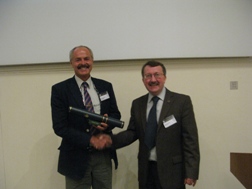 The second of the Society’s Coke medals is awarded to a field geologist who has made an unparalleled contribution to the geological mapping of Africa – Dr Robert Thomas.
The second of the Society’s Coke medals is awarded to a field geologist who has made an unparalleled contribution to the geological mapping of Africa – Dr Robert Thomas.
Now a Principal Geologist at the British Geological Survey, until 2002 Bob Thomas worked for over two decades at the Council for Geosciences and Geological Survey of South Africa. His mapping work, leading large teams through extensive areas of South Africa, Morocco, Mozambique, Madagascar, Gabon, Tanzania and the United Arab Emirates, has made his name known throughout these countries for the provision of the baseline geological maps that underpin their continuing economic development.
As well as pulling together these great teams of geologists and specialist petrologists and cartographers to deliver maps covering vast areas, Bob has co-supervised several PhD students in the field and been invited on national and international expeditions to East Antarctica and the Falkland Islands, in pursuit of Africa-Gondwana connections. He has published over 90 papers and over 100 geological maps, as well as editing major publications such as his 2006 book on the geology of South Africa.
Bob serves on the editorial board of the Journal of African Earth Sciences and is a council member of the International Association for Gondwana Research. He has also acted as national representative for a number of International Geoscience Programme (IGCP) projects related to African geology. Most importantly, Bob has been involved in training and encouraging an impressive number of young geologists in Africa and Europe over a career spanning 30 years.
Robert Thomas, you are a geological mapper of prodigious talent and energy, reminiscent of the heroic era of our science. Your achievements on behalf of the economic development of Africa make you a worthy recipient of the Coke Medal of The Geological Society of London.
Bob Thomas replied:
Mr President, when I first got the e-mail informing me of this prestigious award, I assumed it was one of the sort that occasionally emanates from Africa. But no! it was genuine and I was at first staggered and then truly delighted to have received such an honour from the Geological Society.
It is particularly apt and pleasurable that today also marks the recognition of a lifetime’s high geological achievement by my old friend and mentor, Dick Moody, who tutored me during my formative undergraduate years. Not only was Dick a member of the inspirational teaching staff at Kingston Polytechnic, but he led my first field trip to North Africa.
Thus, began a life-long attachment to the Mother Continent.
It is a great pleasure to share the Coke Medals with another old friend and post-graduate colleague from Queen Mary College, Ian Sims. I am also deeply indebted to my Ph.D. supervisors at Queen Mary, Bill French and Clive Bishop who instilled the disciplines of self-motivation and independent thinking into such a naïve post-graduate student.
A lifetime of fieldwork in Africa does not come without its sacrifices and I am very glad that my wife, Marion, is here with me today. She, along with our three children, has endured my long absences stoically over the last 30 years.
Finally, I would like to thank all my many friends and colleagues in Africa who have always made me feel so welcome. It has been my privilege to pass on some of the knowledge that I have gleaned during my career at two of the World’s finest geological surveys.
Thank you Mr President, once again, it is a great honour to accept this award.
Martin Jackson (William Smith Medal)
 The medal named for William Smith celebrates outstanding achievement in the field of applied geology, and this year we are delighted to present it to Dr Martin Jackson of the Bureau of Economic Geology at the University of Texas at Austin.
The medal named for William Smith celebrates outstanding achievement in the field of applied geology, and this year we are delighted to present it to Dr Martin Jackson of the Bureau of Economic Geology at the University of Texas at Austin.
Martin Jackson is the world’s leading expert on salt tectonics. His fundamental research, in partnership with industry via the Applied Geodynamics Laboratory at Austin, which he founded 25 years ago, has revolutionised oil exploration and development in salt-bearing sedimentary basins - fundamentally changing our view of how passive continental margins evolve.
His Applied Geodynamics Laboratory is one of the most successful and respected industry-research partnerships in geoscience, anywhere. Through this influential consortium he has acted as an exemplary ambassador for the academic geoscience community, helping convince the petroleum industry that this model for conducting research pays dividends well beyond the strict deliverables of any specific project.
Martin’s own research has crossed many disciplinary boundaries, from hard-rock structural geology in the Archaean of Africa to planetary geomorphology and tectonics, latterly with a masterly explanation of valleys and collapse structures on Mars. Through a series of papers, books, monographs and training courses he has raised awareness of salt tectonics, and spread the application of its principles throughout industry and academe.
Martin’s most deeply lasting contribution however is a truly personal one. His inspiring intellectual leadership has spread far and wide through colleagues and students; some laboratories and research groups throughout the world are only functioning today because of his tireless encouragement and selfless support.
Martin Jackson, for your manifold scientific and technical achievements, and as an influential ambassador and inspirational leader in your field, it is my great pleasure to award you today the William Smith Medal of The Geological Society of London.
Martin Jackson replied:
Mr. President, ladies and gentlemen, receiving this medal brings me more pleasure than any other honour of my career. This is the first medal awarded by the Society for research in salt tectonics. So I’m delighted to accept this award on behalf of everyone working in this field - a field that is little taught in universities, but which is a vital part of petroleum exploration.
I strayed quite by chance into salt tectonics. The first 10 years of my career were spent studying the Precambrian of southern Africa: first as a greenhorn prospecting for minerals; then mapping a virgin area of 10,000 square kilometers in the Namib desert for a PhD; then teaching at the University of Natal in South Africa. After this decade of working on old, hard, surface rocks, I was flung into the unfamiliar realm of young, soft, subsurface rocks, on joining the Bureau of Economic Geology at the University of Texas 33 years ago. I was assigned the task of trying to decipher the growth history of a salt diapir and assess its tectonic stability for nuclear-waste isolation. As it turned out, this was an opportune time to begin studying salt tectonics, because this field of study had become fossilized and long overdue for a fresh look. At that time, only one person, Chris Talbot, was publishing creative and original research on salt tectonics. Our collaboration was the start of an exhilarating research adventure, with scores of talented colleagues around the world, and especially at the Applied Geodynamics Laboratory.
During our 44 years together, my wife Jo has not had an avid interest in differentiating allochthonous salt from autochthonous salt, but she has boosted my career far more than she can guess.
To the Geological Society and to colleagues who generously nominated me for this magnificent award, my thanks and gratitude.
Peter Kokelaar (Murchison Medal)
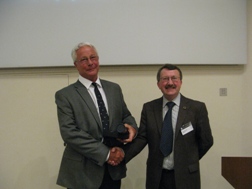 Sir Roderick Impey Murchison was, among his countrymen, one of the 19th Century’s most widely travelled Earth scientists; so it is perhaps appropriate that we award this year’s Murchison Medal to a particularly widely-travelled volcanologist, Peter Kokelaar, George Herdman Professor of Geology at the University of Liverpool.
Sir Roderick Impey Murchison was, among his countrymen, one of the 19th Century’s most widely travelled Earth scientists; so it is perhaps appropriate that we award this year’s Murchison Medal to a particularly widely-travelled volcanologist, Peter Kokelaar, George Herdman Professor of Geology at the University of Liverpool.
Peter Kokelaar is a world-leading innovative geologist who studies the processes associated with explosive volcanic eruptions. His research encompasses the field, petrological, geochemical and experimental study of volcanic systems, and he has written a number of truly seminal papers that now form the basis of the way we understand interaction between magma and water, and what exactly goes on inside our planet’s most terrifying natural phenomenon, the pyroclastic flow.
Peter is very much a geologist’s volcanologist; equally adept and knowledgeable about modern and ancient volcanic systems, from the Ordovician and Silurian volcanoes of Ramsay Island, Snowdon and Glencoe, to recent deposits on the flanks of Stromboli, Soufrière Hills in Montserrat, and Mount St Helens in Washington State.
His contribution to volcanology has been huge. His ability to draw on structural, sedimentological, geochemical, field and experimental information has led to major advances in understanding many diverse aspects of volcanism - how calderas subside; how magma fluidises wet sediment; how post collisional magmas are generated and erupted; how volcanoes are sited and develop in transtensional settings; how Surtseyan magma erupts explosively within aqueous slurries; how granular density currents evolve and deposit with time, and how volcaniclastic sediments behave in active caldera lakes.
He has enthused generations of students at Liverpool and is a fascinating and accomplished communicator of his science to students and public.
Peter Kokelaar, you are indeed a worthy recipient of the Murchison Medal of The Geological Society, which it is my great pleasure to present to you now.
Peter Kokelaar replied:
I am honoured and delighted by this unanticipated recognition. Perhaps most pleasing to me is being added to a long list that includes many of my field-geologist heroes – those who inspired me originally. For Liverpool’s part, it continues something of a tradition, following Shackleton, Pitcher, Flinn and Watterson, although I do feel rather guilty about receiving an award for massively indulging and enjoying myself. A list of my ‘works’ would show that I have wantonly cherry-picked geology in steep places; it is no coincidence that I mapped the rock faces of Ramsey, Snowdon, Scafell and Glencoe, finding superb 3-D exposures of the guts of volcanoes accessible with a little scrambling. I was a climber and mountaineer from school days and geology enabled me to continue the adventures. Quite simply, Aberystwyth University was as near as I could get to Snowdonia, and, by the way, was also prepared to take me without A-levels. It was John Phillips at Aber who launched my career, striding over Cadair Idris and pointing up the volcanic cliffs; his enthusiasm as a teacher was immense and I am most indebted to him. Also, from all the fun, I happily recollect in particular all the Welsh episodes world-wide with my dear friend and mentor Malcolm Howells, and with Ian Moore finding ourselves perched high on ledges above Glencoe and then having difficulty getting down again. And, of course, I must thank my academic soul-mate, Mike Branney, for persuading me to pay proper attention, irrespective of scorpions or horizontal rain.
I am honoured that the Geological Society has considered and included me, with recognition for what, after all, has been a career largely of ‘Boys Own’ adventures. Lastly, I sincerely thank my wife Helen and my family, for their patience, help and companionship; this Murchison medal will be ours.
Paula Reimer (Lyell Medal)
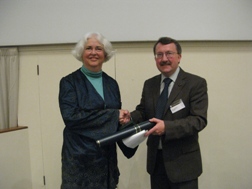 The medal named for one of the 19th Century’s most influential geologists, Sir Charles Lyell, goes this year to a key international figure in the development and application of radiocarbon calibration for a range of geological, archaeological and Earth System Process applications – Professor Paula Reimer of Queen’s University, Belfast.
The medal named for one of the 19th Century’s most influential geologists, Sir Charles Lyell, goes this year to a key international figure in the development and application of radiocarbon calibration for a range of geological, archaeological and Earth System Process applications – Professor Paula Reimer of Queen’s University, Belfast.
Paula Reimer’s research covers four main areas: radiocarbon dating and calibration; marine and freshwater radiocarbon reservoir effects; sourcing carbon in diets and food webs, and carbon-cycling in peats, soils and sediments. However she is especially renowned for her work on calibration and her leadership of the international working group IntCal, which compiles the internationally ratified radiocarbon calibration curves. This work, stretching over a period of 25 years, has led to more than 12,000 ISI Web of Science citations.
Together with Minze Stuiver, Paula Reimer created one of the first computer program for the calibration of radiocarbon ages, converting them to a calendar timescale comparable with other age estimates. That was in 1986. In developing CALIB 3.0 in 1993, the authors produced a more sophisticated version of the software, whose benefit and utility is indicated by its receiving almost 3500 citations in the literature.
She has played a major role in the formation of the IntCal working group as a global collaborative effort for improving calibration, and subsequently led the initiative, of which she remains as Chair; authoring key publications in the field in 2004 and 2009. These latter papers alone have garnered almost 3000 citations to date. The wide interest in radiocarbon dating that extends across the geological and archaeological sciences has led to huge impact and use of her key papers.
In addition, Paula Reimer has been especially prominent in developing marine radiocarbon calibration, and a wide variety of Earth System Science applications, such as the dating of hyrax middens in Africa for palaeoclimate reconstruction, and understanding the long-term cycling and accumulation of carbon in boreal peat lands.
Paula Reimer, your contribution to the field of radiocarbon dating and carbon cycling in the environment has been exemplary. It is my great pleasure to acknowledge this invaluable work by awarding you the Lyell Medal of The Geological Society of London.
Paula Reimer replied:
Thank you, Mr President. I am deeply honoured to have been selected by the Geological Society to receive this prestigious medal.
I first became involved in radiocarbon dating and calibration when I went to work for Prof. Minze Stuiver at the Quaternary Isotope Lab in the University of Washington, first as a technician and then a scientific programmer. There I learned not only the basics of radiocarbon dating but also the value that radiocarbon and other isotopes can bring to understanding the global carbon cycle. I also learned the benefits of collaboration, which is instrumental in the continued refinement of the radiocarbon calibration curves.
Radiocarbon calibration curves have changed from simple averages of tree-ring 14C measurements in the early days. Measurements on other types of archives, such as corals, stalagmites and varved sediments, with distinctly different problems and uncertainties, have been incorporated to extend the marine and terrestrial calibration curves to 50,000 years before present, thereby increasing its utility for Late Quaternary studies. These archives are evaluated and statistically combined by the IntCal Working Group. The IntCal group is composed of a number of brilliant, and mostly congenial, scientists and statisticians who represent a cross-section of the entire radiocarbon community. It is their dedication and efforts over the years that have facilitated the progress in our understanding of the mechanisms behind atmospheric and marine radiocarbon variations and their relationship to the global carbon cycle. I want to thank you, Mr President, and the Geological Society of London for recognizing the value of this effort. I gratefully accept the Lyell Medal not only on my behalf but also on the behalf of my colleagues.
Kurt Lambeck (Wollaston Medal)
Editor's note: Sadly, owing to an unfortunate diary mix-up, Kurt Lambeck was not present for the presentation. He will be delivering a public lecture at Burlington Housse on 25 September 2013, at which the presentation will finally be made.
Finally, we come to the Wollaston Medal – the Society’s senior medal and highest accolade, first awarded to William Smith in 1831.
Kurt Lambeck of the Australian National University in Canberra is this year’s laureate - and is internationally recognised as, unquestionably, one of the greatest living Earth scientists. His numerical simulations of the interactions between surface processes and the solid Earth, notably glacial isostatic deflection, glaciations and sea-level, have led to multiple breakthroughs in Earth System Science, and his work on climate and sea level has been recognised by the highest authorities.
Kurt Lambeck’s achievements in geology cover an amazingly wide range. He has contributed significantly in geophysics, geodesy and geology, especially on interactions between the solid Earth and the processes that take place on its surface. He has studied the Earth’s gravity field, tidal and rotational effects upon the planet, the evolution of the Earth-Moon orbital system, lithospheric and crustal deformation processes, sea-level change and the history of Earth’s ice-sheets during glacial cycles, and the impact of sea-level changes on ancient civilizations – leading him to speculate about their possible future impact on our own civilization.
The applications of his work are therefore extraordinarily diverse. His work on climate change and sea level has influenced the conclusions of the Intergovernmental Panel on Climate Change, and he is well known in this country through his glacial isostatic adjustment modeling, relating to the British and Fennoscandian ice sheets - and significant contributions published in the Journal of the Geological Society.
Kurt Lambeck has worked in many countries; as a geodesist at the Smithsonian Astrophysical Observatory and Harvard Observatory, and as Professor of Geophysics at the University of Paris. He has been Director of the Research School of Earth Sciences at the Australian National University, and represented his native Australia on the IPCC and has been a member of high level government committees, including the Antarctic Science Advisory Council as Chair, the Prime Minister’s Science, Engineering and Innovation Council, the Prime Minister’s Science Prizes Committee and the Higher Education Endowment Fund Advisory Committee. He was also President of the Australian Academy of Science from 2006 to 2010, to which distinguished body he was elected in 1984.
Unsurprisingly, given such a record, Kurt Lambeck has received many international awards and distinctions. He is a Fellow of the Royal Society, the Royal Netherlands Academy of Arts and Sciences, the Norwegian Academy of Science and Letters, the Academia Europaea, the French Académie des Sciences, and the US National Academy of Sciences and American Academy of Arts and Sciences. He is an Officer of the Order of Australia and a member of France’s Légion d'Honneur, recipient of the Charles A Whitten Medal of the American Geophysical Union, the Jaeger Medal of the Australian Academy of Science, the Alfred Wegener Medal of the European Union of Geosciences, the Erlander Prize of the Swedish Research Council, the Prix George Lemaitre of the Université Catholique de Louvain, and the Eminent Scientist Award of the Japan Society for the Promotion of Science. He also won the 2012 Balzan Prize of the International Balzan Prize Foundation for his ‘exceptional contribution to the understanding of the relationship between post=glacial rebound and sea level changes’.
My apologies if I have missed anything out. Kurt Lambeck, it gives me the greatest pleasure to acknowledge your outstanding achievements by adding to these many awards the Wollaston Medal of The Geological Society of London.
Kurt Lambeck replied:
Thank you, Mr President, for your citation. I do ask myself if you have made a mistake and were talking about someone else! For when I look at that long list of recipients of the Wollaston Medal I am truly amazed and humbled to find myself amongst them. I did not come to geology via the traditional route and I must admit that I have only ever followed one geology course in my university career. However, when I look over the list of recipients I do see others who have had unconventional journeys and I am comforted. So, thank you, the Geological Society, for taking such a broad view of the geological sciences.
My early University training was in geodesy in Sydney when satellites were first used for positioning and gravity field determination. This led, via some detours, to Oxford and a D. Phil. This may have seemed an odd choice, but it had the advantage of balancing the rigor of my earlier graduate training in Delft and the empiricism of subsequent training in Athens with the pragmatism of Brigadier Bomford's approach, while leaving me free to pursue a range of other interests.
Oxford led to the Smithsonian and Harvard Observatories and to my first substantive work in determining the Earth's gravity field from the perturbations in the orbits of satellites. It was this results that led me into geophysics: the interpretation of the new results became a much more attractive proposition than continuing to improve gravity field models.
France, with a rapidly developing space program in the late 1960's, provided me with the opportunities to make this transition as well as to place satellite geophysics more centrally into their program. France also provided me with some superb support from mathematicians and engineers that together allowed us to make rapid progress in global geodynamic problems, particularly planetary tides and rotation.
At some point the call home became strong and I was enticed to join the Australian National University. Opportunities to develop a satellite geodesy program at that time were slim unless I was prepared to spend my time commuting to France and the US. This was not sustainable and, besides, there were some interesting geological problems to address: the mid-continental basins that defied all current thinking about their formation. This became my introduction to geology and geologists and we had interesting arguments that did ultimately lead to new insights and, more importantly, to renewed interest in the geology of the area and to some major new geophysical experiments.
The next change in direction, towards the earth-ice-ocean interactions during glacial cycles, was also due to support from colleagues and later students, and also led to a happy and interesting interaction with the geological community. I like to think, Mr President, that the work that you referred to provided a significant new focus for field-based sea-level studies in Britain. I will talk about some of this work later.
Over a career one collects many debts to mentors, colleagues, students and rivals. Without them my research career would never have been launched. I thank them all. I mentioned that Oxford gave me the opportunity to pursue other interests. One of them is here today, my wife of some 45+ years who has given me her unstinting support and forbearance throughout my journey of science.
Through you, Mr President, I thank the Geological Society for awarding me with the Wollaston Medal. I treasure it.
ENDS